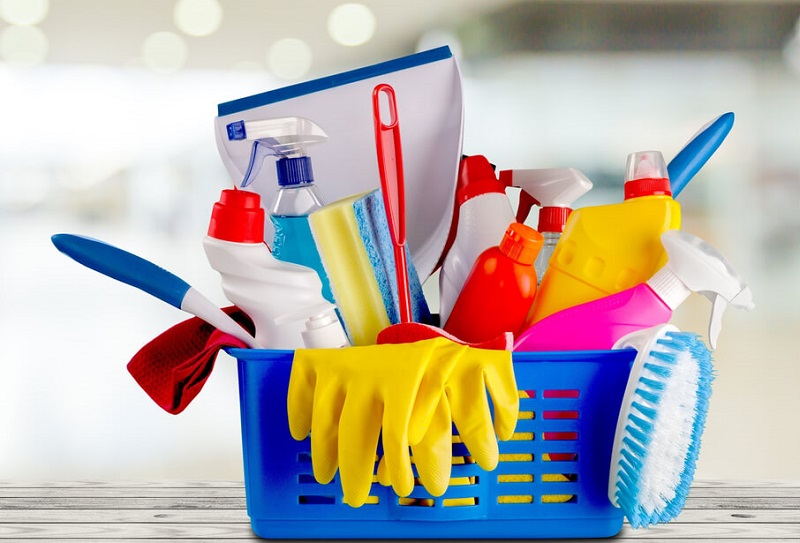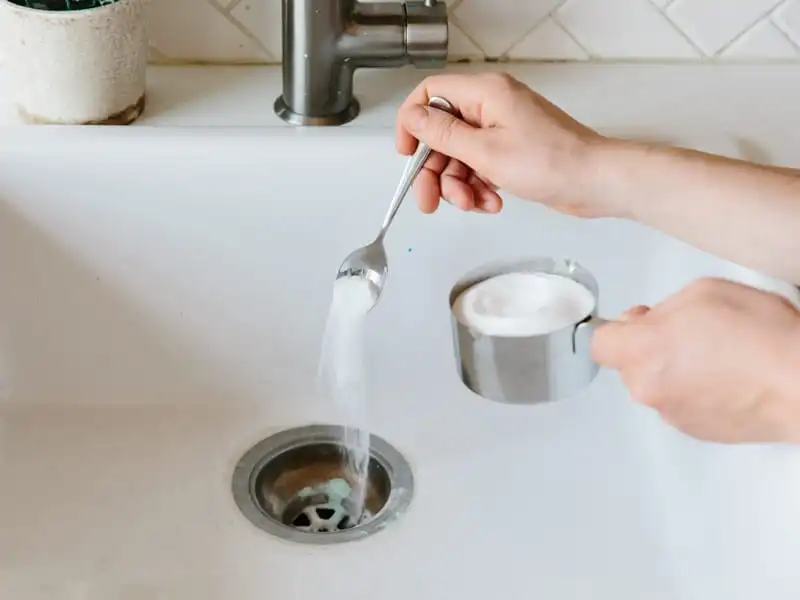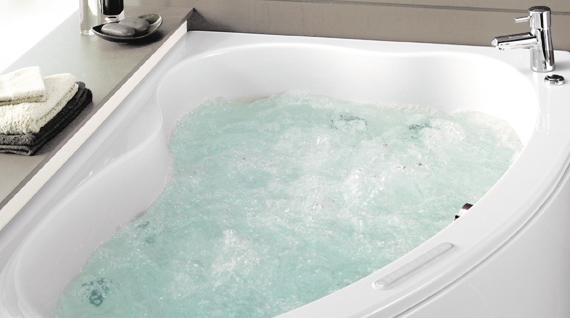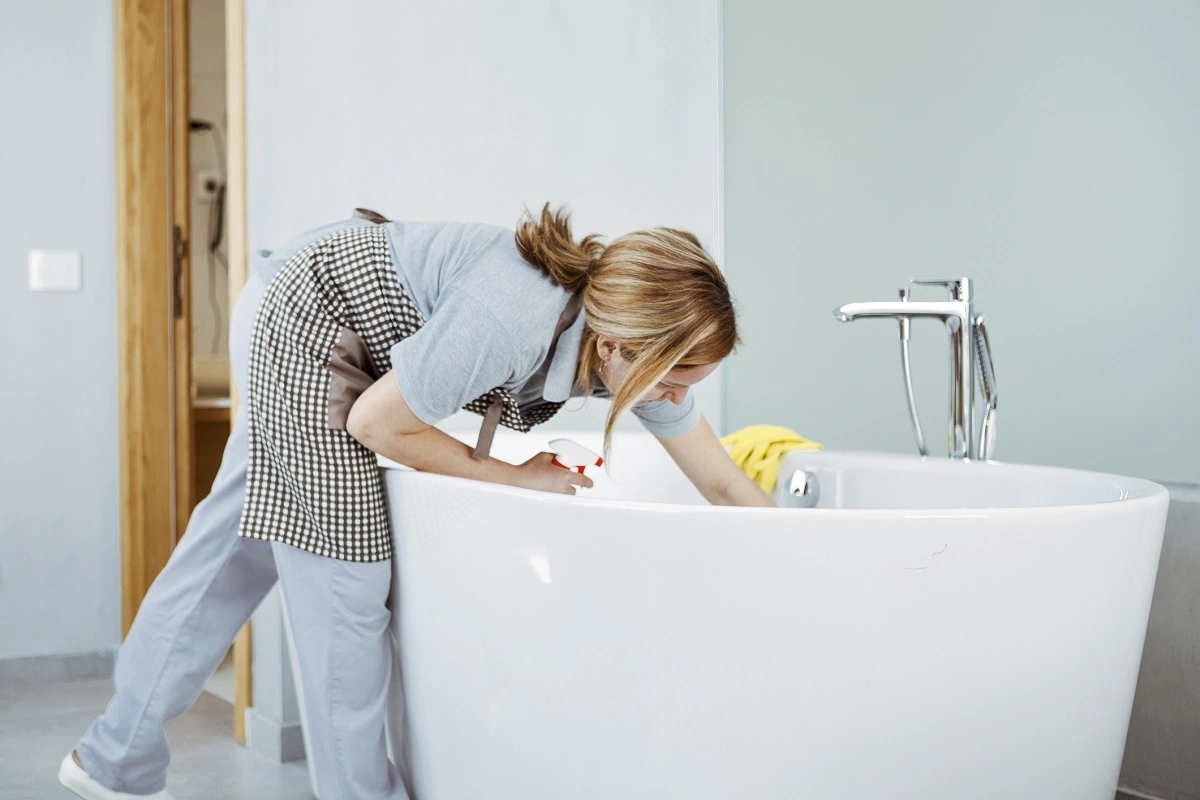Ah, the bathtub. A haven of relaxation, a way to take care of yourself, and sadly, a dirt magnet. Mineral buildup, soap scum, and mildew can quickly turn your peaceful haven into a dirty disaster zone. But don’t worry, tired bathers! You can make your tub look brand new again with a little know-how and hard work.
Step 1: Get your weapons together

Gather your cleaning army before you start doing the sudsy work. You will need these things:
- Rubber gloves: Wear rubber gloves to keep your hands and feet safe from dangerous chemicals.
- Sponge or soft scrub brush: Pick one that isn’t rough to keep the surface from getting scratched.
- Microfiber cloths: These are soft and can be used to dry and clean.
- All-purpose cleaner or baking soda: Opt for eco-friendly options if possible.
- Vinegar or bleach: For tackling tough stains and mildew.
- Bucket: For mixing cleaning solutions and rinsing.
- Grout brush: For those hard-to-reach corners.
Step 2: Get to know your enemy
There are different ways to clean bathtubs made of different materials. Here is a quick guide:
- Acrylic: Acrylic is easy on the hands but hard to scratch. Do not use rough cleaners or scrubbing pads. You should use baking soda paste.
- Cast iron: Cast iron is strong, but it rusts easily. To get rid of rust spots, use mild cleaners and vinegar.
- Porcelain: Porcelain is classic and beautiful, but it can be etched. Neutral pH cleaners and soft brushes are the best way to go.
- Fiberglass: It’s light and doesn’t scratch easily, but it can be damaged by strong chemicals. You should use baking soda and dish soap.
Step 3: The Soak Before the Battle
Put warm water into the tub and add a lot of baking soda or all-purpose cleaner. Leave it alone for 15 to 20 minutes while you collect your thoughts or make plans for your Netflix marathon after a bath. This pre-soak breaks up dirt and makes it easy to scrub.
Step 4: The Scrub-a-Dub-Dub
The fun (sort of) part is now here. Get your sponge or brush ready and start scrubbing! Move around in a circle and pay extra attention to the drain, corners, and tap handles. Don’t forget the bottom of the pan; that’s a great place for soap scum to grow.
Step 5: The Targeted Takedown
Use your special tools on stains and mildew that won’t come off:
- Fill a spray bottle with equal parts vinegar and water. Rub it on hard water and mildew spots, wait a few minutes, and then rinse.
- Bleach: Only use it on ceramic or acrylic tubs and not on other tubs. Mix a tablespoon of bleach with a gallon of water. Wear gloves and make sure the bathroom has enough air flow.
- Grout brush: Use a grout brush that has been dipped in your cleaner to clean grout lines.
Step 6: The Rinsing Ritual
Clear water should be used to rinse off all of the cleaning product. For better reach, fill up a bucket with water and pour it over the area.
Step 7: The Polishing Finale
Use a microfiber cloth to buff the tub to a brilliant shine. In the end, your tub will be free of water spots and shine like new.
Step 8: Bonus Round – Drain Patrol
Don’t let a jammed drain ruin your clean tub. First pour a cup of baking soda down the drain, then a cup of vinegar. Soap scum and hair clogs will be broken down by the fizzing. Finally, use a pot of hot water to wash everything away.
Step 9: Maintenance Magic
These easy steps will keep your tub sparkling between deep cleans:
- Rinse the tub every time you use it to keep soap scum from building up.
- To avoid water spots, wipe the tap and drain down with a dry cloth.
- Leave the bathroom curtain open so that the tub can dry naturally and keep mildew from growing.
- Use a light cleaner to give it a quick clean once a week.
Step 10: Reward Yourself!
It’s time to enjoy the sweet win now that your tub shines. Put on your best music, light some candles, and take a long, relaxing bath. You’re due it!
Always put safety first! When working with strong chemicals, you should always wear gloves, and the bathroom should have a lot of air flow.
Your bathtub will be the talk of the town (and maybe even Instagram) after you use these tips and tricks. So go out there, beat the grime, and take back your peaceful sudsy haven!
How to clean a dirty bathtub without scrubbing
You can clean your bathroom without working too hard in a number of ways:
1. Powerhouses of nature:
- To make a vinegar bath, add two cups of vinegar to hot water in the tub. Leave it alone for half an hour to an hour, then drain and rinse it. This gets rid of mineral buildup, soap scum, and dirt.
- Baking Soda Paste: Mix baking soda and water to make a paste. Put it on the spots that are stained and wait 15 to 20 minutes. Rinse with hot water to clean gently but well.
- Slice lemons, oranges, or grapefruits in half and rub the halves on the spot. The acidity gets rid of dirt, and the citrus smell leaves a clean scent.
2. Soak and Spray Solutions:
- Enzyme Cleaners: Enzyme cleaners help get rid of organic matter like hair and soap scum in an eco-friendly way. Add warm water to the tub, then follow the directions on the enzyme cleaner and let it sit for the time given. Rinse really well.
- Tea Tree Oil: Mix a few drops of tea tree oil with water and spray it on spots of mildew. Wait a few minutes and then rinse it off. Natural antifungal qualities can be found in tea tree oil.
- Dish Soap Surprise: Put some dish soap in your tub and fill it with warm water. Move the water around to make bubbles, then let it sit for 15 to 20 minutes before running clean water through it. Dish soap gets rid of dirt and grease.
3. Gadget Helpers:
- Handheld Steamer: Mold and soap scum can be steamed out of hard-to-reach places with a mobile steamer. Watch out not to use it on soft areas.
- Electric Scrubber: To clean specific areas, buy an electric cleaner with heads that can be switched out. It can really help you get rid of grout lines and tough spots.
Remember that you may still need to scrub some spots or heavy dirt by hand. But if you follow these tips and get creative, you can have a clean, sparkling toilet without having to work hard.
How to Clean a Bathtub Drain

It can be a pain to deal with clogged bathroom drains, but luckily there are many ways to fix them without using harsh chemicals or calling a plumber. From natural treatments to useful tools, here are some things to think about:
1. Natural Alternatives:
- Baking soda and vinegar together: This tried-and-true pair does great things! First, put half a cup of baking soda and then a cup of vinegar down the drain. The fizzy process breaks up organic matter and loosens up clogs. Do not flush for 15 to 30 minutes. Then use hot water.
- Boiling water: Easy and effective! A pot of water should be boiled and then slowly poured down the drain to get rid of soap scum and hair buildup. If needed, do it again.
2. Machine-Based Methods:
- Plunger power: It means to use a cup plunger very hard for a few minutes. This can help get rid of clogs that are closer to the surface.
- Drain snake: This tool can get to deeply clogged drains and grab hair or other waste. Carefully put the snake in and twist it to grab the clog. Then, pull it out and throw it away.
- Zip-it tool: The Zip-it tool is very useful. It has small hooks that grab hair and other things as you pull it through the drain. It’s a mess-free way to get rid of hair clumps.
3. Commercial Cleaners:
- Enzyme cleaners: These eco-friendly items break down things like hair and soap scum. Follow the directions on the bottle and pour the cleaner down the drain. Let it sit for the time given, then flush with hot water.
- Chemical drain cleaners: When you really need to clean out your drain, don’t use chemical drain cleaners. They can damage your lines. Carefully follow the directions at all times and don’t mix with other poisons.
4. Tips for Prevention:
- Drain cover: Get a drain cover to keep hair and other things from going down the drain.
- Regular cleaning: To keep the sink clean, pour a pot of hot water down it once a week.
- Don’t use strong products. Some shampoos and soaps can leave behind residue that makes clogs worse. If you can, pick choices that aren’t as strong.
Remember: Make sure there is no water in the tub before you start cleaning it. If it doesn’t drain at all, the clog may be deeper in the pipes and needs to be fixed by an expert.
If these don’t work and the clog still exists, don’t be afraid to call a professional plumber for help. They have the right tools and know-how to clear out even the toughest drain clogs.
How to clean a fiberglass(plastic) bathtub
Even though fiberglass tubs are great because they are light and sleek, they need special care to keep their shine. How to clean your fiberglass tub so it shines again without hurting it:
1. Prep and Gather:
- Clean up: Get rid of any toys, bath products, or other junk from the tub and the area around it.
- The material is important. To choose the right cleaning products, you need to know what kind of finish your fiberglass has (glossy, matte, etc.). Some surfaces can be hurt by harsh chemicals.
- Get your weapons ready: choose mild cleaners like baking soda, vinegar, dish soap, or light commercial cleaners made just for fiberglass. Stay away from bleach and rough abrasives. Get sponges, soft brushes, microfiber cloths, and maybe even a spray bottle ready.
2. Getting rid of the grime:
- Soap scum and grime: To get rid of soap scum and dust, mix baking soda and water to make a paste. Put a lot of it on the tub’s surface and wait 15 to 20 minutes. Carefully scrub the surface with a sponge in a circle, paying special attention to edges and cracks. Use warm water to rinse well.
- Mineral deposits and hard water stains: Put one part vinegar to two parts water in a spray bottle. This will get rid of mineral buildup and hard water stains. Spray it on the places that need it and wait 10 to 15 minutes. Then, use a soft brush or sponge to scrub it gently. Use clean water to rinse well.
- Tough stains: mix baking soda and lemon juice to make a paste. Use this on rust. Put it on, wait 15 to 20 minutes, then scrub and wash it off. For food spots, dish soap that has been watered down might work. Always try a new solution on a small spot that won’t be seen first.
As a preventative step, rinse the tub quickly with clear water after every use to keep soap scum and mineral deposits from building up. When you clean regularly, you don’t have to do deep cleaning as often.
Remember to always check the cleaning instructions that came with your fiberglass tub to make sure you’re using the right method and products.
Thanks for these tips. With a little care, your fiberglass bathtub will be nice and shiny in no time. If you have any special questions about how to clean your tub or get rid of stains that won’t come out, don’t be afraid to ask. I can help you get rid of the fiberglass grime and keep your swimming area clean.
How to Clean a Jacuzzi Bathtub

With their jets and bubbles, Jacuzzi spas make bathing very relaxing, but they need special care when cleaning. Care for your tub and keep it clean and healthy with these steps:
1. Regular Maintenance:
- After each use: Run the jets for a few minutes with clean water after each use to get rid of any dust that is still there. To get rid of hair and soap scum, drain the tub and wipe the surface down with a clean cloth.
- Twice a week: Fill the tub with warm water and add a small amount of light dish soap. Let the jets run for 10 to 15 minutes, then drain and rinse well.
2. Deep Cleaning:
- Monthly deep clean: Follow the instructions for your specific jacuzzi model, but generally, the process involves:
- Filling the tub with warm water and a jacuzzi cleaning solution or diluted vinegar (check suitability for your materials).
- Running the jets for 15-20 minutes.
- Draining and rinsing thoroughly.
- Cleaning the filter according to the manufacturer’s instructions. This usually involves soaking in a cleaning solution and rinsing well.
- Using a jet cleaner (if the model has one) according to the instructions.
- Annual deep clean: Deep clean once a year, If you live in an area with hard water, you might want to have a trained technician clean your pool for you.
3. Deal with Specific Problems:
- Mineral deposits: Clean the damaged areas with a vinegar solution or a store-bought hard water stain remover. Let it sit for 10 to 15 minutes, then scrub it gently and rinse it off.
- Mold and mildew: Be careful when using a weak bleach solution (one part bleach to four parts water) if you see mold or mildew growing. Put on gloves and let air flow through the bathroom. After, make sure to rinse well.
- Stains: Use the right stain removers for rust or dye spots, making sure they won’t harm the materials in your jacuzzi. First, you should always test on a small, hidden spot.
4. Tips and Tricks:
- Regular ventilation: Make sure the bathroom has enough air flow after each use to stop mold and mildew from growing.
- Cleaning the cover: Wipe down the jacuzzi cover with a light soap solution every so often. Make sure it’s totally dry and airy before putting it back on.
- Buy a water softener. If you live in an area with hard water, you might want to install a water softener to keep minerals from building up.
5. Safety First:
- Always turn off the jacuzzi’s power before cleaning it.
- Carefully follow the directions given by the maker.
- When using cleaning chemicals, protect your hands and eyes with gloves.
- Bleach should never be mixed with other cleaners.
Following these tips and keeping up with normal cleaning will make sure that your jacuzzi bathtub is always ready to take you on a spa trip. Don’t forget to get in touch if you have any special questions about your jacuzzi model or are having trouble cleaning it. I’m always happy to help you find your way around the bubbly depths and keep your pool a clean and relaxing haven.
FAQs: Your Soapy Questions Answered
It might seem hard to master the bathtub, but with a little help and these frequently asked questions, you’ll be soaking in sparkling peace in no time!
Q: I’m not sure whether to use vinegar or baking soda. Which one is better?
Baking soda and vinegar are both great natural cleaners, but they do different things well:
- Baking soda is a mild abrasive that gets rid of soap scum and greasy buildup. It works great for shining and general cleaning.
- Vinegar is an antiseptic and gentle acid that gets rid of mineral buildup and mildew. Great for getting rid of tough spots and stopping mold from growing.
The best choice depends on the stain:
- General cleaning: Mix baking soda with water for a cleaning paste.
- Soap scum: Sprinkle baking soda directly on the surface and scrub with a sponge.
- Mineral deposits: Spray vinegar on the affected area and let it sit for 10-15 minutes before rinsing.
- Mildew: Combine vinegar and water in a spray bottle and apply directly to the mildew.
Q: My bathtub is old and scratched. Can I still make it shine?
You can fix even scratched tubs! Here are some ideas:
- Do a deep clean: To get rid of all the dirt, use baking soda paste or a light cleaner to clean everything really well.
- Cleaner: To get rid of small scratches and bring back the shine, use a metal cleaner made just for tubs that isn’t rough.
- Touch-up: If the scratch is deeper, you might want to get a tub touch-up kit in the same color. Follow the directions and let it dry totally.
Q: What’s the best way to clean a cast iron tub?
Yes, cast iron tubs last a long time but are easy to rust. The best way to keep them spotless is to:
- Stay away from harsh chemicals. Instead, use light dish soap or baking soda paste.
- To get rid of light rust spots, mix vinegar and water together. For tougher rust, use a store-bought rust cleaner made just for cast iron.
- Season the surface: Use a thin layer of mineral oil to keep the surface from rusting and give it a light shine after cleaning it.
Q: How often should I clean my tub?
It depends on how often you use it and the type of water where you live.
- Once a week: Rinse it off and wipe it down after each use.
- Deep clean: Once a week or every two weeks, clean everything really well with baking soda or a light cleaner.
- Extra care: Clean your tub more often to stop mineral buildup and mildew growth if you live in a wet area or have hard water.
Q: My drain is clogged! Help!
Don’t panic! These tips can unclog your drain without harsh chemicals:
- Baking soda and vinegar
- Plunger power
- Boiling water
It is important to remember that mixing baking soda, vinegar, and chemical drain cleaners can be risky.
Q: My bathtub has a weird film on it – what is it and how do I remove it?
That mysterious film could be several things:
- Hard water deposits: These are a white or chalky film that is caused by minerals in your water. Use vinegar or a store-bought hard water stain cleaner to clean.
- Soap scum residue: This is a filmy substance that soap and body products leave behind. You can use baking soda paste or a store-bought soap scum cleaner.
- Mineral oil sheen: If you put mineral oil on a cast iron tub not long ago, it may leave a light sheen. Use a cotton cloth to smooth it out.
Q: Is it safe to clean my bathtub with bleach?
Bleach can be effective for tough stains and mildew, but use it with caution:
- Only on porcelain or acrylic tubs: Bleach can damage other materials like cast iron or fiberglass.
- Dilute it properly: Mix one tablespoon of bleach per gallon of water.
- Ventilate the bathroom: Open windows or turn on the fan to avoid inhaling fumes.
- Wear gloves and protective eyewear: Bleach is harsh on skin and eyes.
Q: I have a whirlpool tub – how do I clean it properly?
Whirlpool tubs require special attention:
- Check the manufacturer’s instructions: Follow specific cleaning recommendations for your model.
- Deep clean the jets: To get rid of bacteria and mineral buildup, use a jet cleaner or a vinegar solution.
- Don’t use harsh chemicals: . Bleach and other rough cleaners can hurt the jets.
- Run the sanitizing cycle often. This is a built-in function of most whirlpool tubs that keeps them clean and germ-free.
Q: How can I prevent my bathtub from getting stained in the first place?
Don’t let anything get into the tub;
- Rinse every time you use it. This gets rid of soap scum and residue before they can stick around.
- Squeegee the walls to get rid of water spots and soap scum.
- Clean the sink and faucet. This stops mineral buildup and mildew growth.
- Make sure there is good air flow in the bathroom. This will cut down on the wetness that can cause mildew.
- Don’t use harsh shampoos and soaps. Some of them can leave spots that won’t come out.
Q: Is it possible to fix my broken bathtub?
Yes, a tub touch-up kit can fix small chips. Pick a color that goes with your tub and carefully follow the directions. For bigger chips, you should get them fixed or replaced by a professional.
Related Articles
- How To Clean A Bathtub : A Guide to Sparkling Bathtub
- How much does a Houston house cleaning service cost?
- Is it a waste of money to clean my ducts? Things You Need to Know
- Top 10 Air Duct Cleaning Companies in Houston
- How Long Does Dry Cleaning Take: Unveiling the Mystery of Turnaround Times
- Is Cleaning Worth $19? Pros and Cons things that need to know
- How much does dry cleaning cost? – Get the Prices in 2024
- Is it safe to clean dishwasher with vinegar?
- Who Needs Cleaning Services? You Might Be Surprised!
- House Cleaning Services Woodinville, WA
